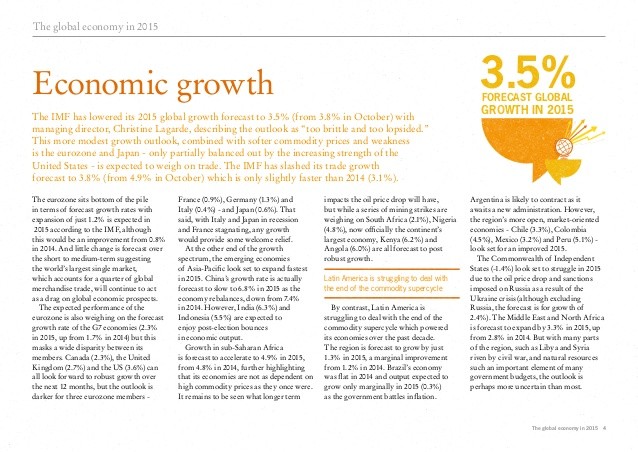US economy Why I m optimistic about growth in 2015
Post on: 16 Март, 2015 No Comment

ADVERTISEMENT
- The economy grew by nearly 5 percent in the third quarter of 2014, after 4.6 percent growth in the second quarter. That’s a giant increase from the 2 percent rut the economy has been mired in for the past six years.
- Hiring is finally starting to pick up its pace, albeit still too slowly to get those who have dropped out of the labor force back into jobs.
- The Dow topped 18,000.
All of this is good news as we ring in the new year. And the best may be yet to come.
The big challenge for the economy in 2015 is raising productivity so Americans get a well-deserved pay raise.
So why is the economy finally shifting into a higher gear? This isn’t a story of government-directed growth or stimulus spending. It’s the opposite: Washington’s role in the economy is starting to shrink after years of Obama administration activism. The private sector is starting to take over.
Making sense of a rollercoaster economy
The growth was propelled by a big rise in business investment, up nearly 9 percent; personal consumption, up 3.2 percent; and exports, up 4.5 percent.
Government spending, which is a negative for the economy, grew by 4.4 percent, thanks to a big rise in military spending, but domestic spending is still restrained.
The news was so good that even the threat that the Fed will now have an excuse to raise interest rates hasn’t deterred the bulls on Wall Street.
Here is the case for optimism going forward.
First, a huge factor in the economic rebound has been the fall in energy costs. As the price of oil has fallen from $105 a barrel this summer to closer $70 by September, (and at the end of December it was at $53) the cost of oil imports has tumbled. Imports fell by nearly 2 percent, and this alone added almost 0.2 percentage points to GDP growth.
Even that greatly understates the economic windfall from cheap energy. Production costs fall when energy costs do, so the supply of American-produced non-oil and gas products, such as manufactured goods, rises when gas is cheap. Gas prices should continue to fall, the good-news story rolls on, and the addition to GDP from energy should be even higher. Thank you, Texas and Oklahoma and North Dakota. And thank you, fracking.
Second, businesses are clearly feeling less trepidation about investing, and some of the wet blanket of Obama’s anti-business, anti-shareholder agenda has dissipated as the Republican Congress repels his worst ideas: cap-and-trade, minimum wage hikes, new taxes on the energy industry and massive new spending initiatives out of Washington. Gridlock now looks to be built into the political system for the next two years, and in many ways that’s reassuring.
Third, government spending has fallen a lot more than people think.Despite the boost in military spending in the last quarter, the biggest story of the U.S. economy over the last three years has been the retrenchment of government spending.
Federal spending has fallen from 24.4 percent of GDP in 2009 and 23.4 percent of GDP in 2010 to 21 percent of GDP in 2014. Even better news is that in the fourth quarter of 2014, federal spending as a share of GDP fell to below 20 percent, according to a new analysis by Dan Clifton of Strategas, an economic policy consulting firm. This is creating an anti-Keynesian boost to growth, because the government is taking fewer private sector resources each month.
The 4 percentage points less of GDP that the government is spending means 4 percent more GDP for private businesses and families to spend. That’s close to $700 billion a year more for private investment and construction and spending.
This, by the way, shows the foolhardiness of the Keynesian notion of a government-spending free lunch. Five years ago the Obama economics team was talking about multiplier effects from higher federal outlays — the stimulus bill spent $830 billion — that would juice the economy with even more private spending.
It never happened. Even President Obama’s own economic analysis found the economy grew more slowly than it would have without the government debt-financed spending. The real effect of government spending is to crowd out private spending.
A final reason for optimism is that the incoming class of Republican governors and conservative state legislators across the country should mean more growth policies coming out of state capitals. At least a dozen governors from Massachusetts to Illinois to Tennessee are talking about tax cuts to create jobs. So even if we don’t get tax reform at the federal level, states should be providing an additional tax cut stimulus.
Skeptics will say that Obama’s executive actions on climate change, immigration, energy policy and so on will continue to be a restraint on growth. That’s for sure.
This recovery from recession is still nearly $2 trillion behind where we should would be if we had a Reagan-paced boom. This is still one of the most anemic recoveries, though it is belatedly picking up steam.
It’s also true that wages are still flat for most workers, so the big challenge for the economy is raising productivity so Americans get a well-deserved pay raise.
As 2014 comes to a close, here’s where we are: Interest rates are as low as they’ve been in 40 years; inflation is tame, thanks to the surge in oil and gas output; and corporate profits remain high.
The rest of the world economy, from Germany to Japan to Russia, is a debacle. But that’s all the more reason to bet on the USA in 2015.
And, no, Mr. President, you didn’t build that.
Stephen Moore is a Fox News contributor. He serves as chief economist at the Heritage Foundation.














